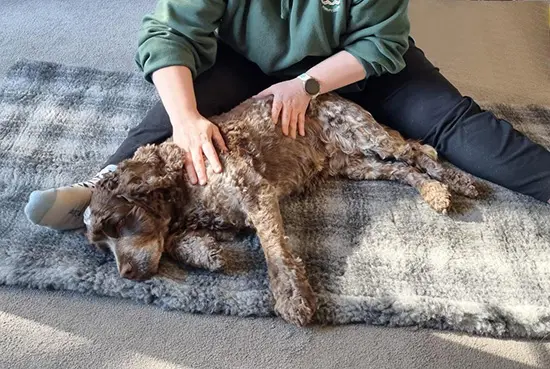Managing your Dog’s Osteoarthritis with Clinical Canine Massage Therapy

If your dog is experiencing symptoms of osteoarthritis or if your vet has diagnosed osteoarthritis, you are not alone. According to Canine Arthritis Management1, this orthopaedic condition “affects 80% of dogs over the age of 8 years old, and potentially up to 35% of dogs of all ages”. Not only can osteoarthritis affect dogs of all ages, it can also affect any breed, however, some breeds are more predisposed than others e.g. Labrador Retrievers, German Shepherds, Golden Retrievers and Great Danes, to name just a few.
As a pet parent myself with a dog diagnosed with osteoarthritis, I know how worrying it can be but it is not all bad news as the condition can be very well managed, meaning that our dogs can still lead happy and fulfilled lives.
What is Osteoarthritis?
Osteoarthritis is a degenerative condition that can affect any joint in the body, with the most commonly affected joints in dogs being the shoulders, elbows, hips, stifle (knee) and the spine. Joints comprise of two or more connected bones which are capped with cartilage, providing lubrication and a smooth surface to allow for frictionless motion, preventing the bones of the joint from making contact with each other.
Osteoarthritis occurs when the joint cartilage is gradually worn away and is not replaced which leads to the reduction of the joints shock absorption. Over time, the bones will come into contact with each other, causing inflammation and the production of osteophytes (bony projections) around the joint margins, remodelling the bone into a rough and misshapen structure that hampers the natural range of movement in the joint.
If you think this sounds painful, you are not wrong! Chronic pain is one of the main symptoms of osteoarthritis. Whilst the condition cannot be cured, the associated pain can be managed to improve the dog’s quality of life.
Symptoms of Osteoarthritis
Symptoms will vary between individuals and can range from mild to severe. Common symptoms include:
- Lameness
- Stiffness – particularly after exercise or periods of rest
- Changes in posture
- Difficulty getting up from laying down
- Reluctance to exercise or slowing down on walks
- Reluctance of difficulty jumping in/out or the car, on/off the sofa, navigating stairs
- Restlessness
- Panting
- Difficulty getting comfortable
- Swollen joints
- Creaking in the joint
- Changes in behaviour/mood
- Licking of the joints
- Unwilling to be groomed/stroked
- Loss of appetite
If you have noticed any of these symptoms in your dog, it is time to pay a visit to your vet for further investigation.
Managing Osteoarthritis with Clinical Canine Massage
You may be wondering how Clinical Canine Massage can help a condition that affects the bones of joints. Let me explain….
Movement of the body is generated by contractions of the muscles that sling over joints, which cause the tendons to pull on the bones, resulting in movement. When there are degenerative changes in the joint, the muscles that cross the joint start to work harder as they attempt to protect the joint from further injury. This phenomenon is termed splinting and causes muscles to become stiff, short and tight, which then contributes to further wear and tear of the joint.
So not only is the dog experiencing pain from the joint itself but now the tight, stiff muscles are contributing to the pain too.
It is not only the muscles and soft tissue that are associated with the arthritic joint that will be affected. As the dog changes their gait and posture as a result of pain, other areas of the body will come under strain due to overcompensation. In dogs that I treat, I often find that other, seemingly, unrelated areas of the body will have changes that appear to be more painful than the affected joint itself. For example, dogs with osteoarthritis in their elbow will often have changes in the muscles of their hindlimbs and lumbar spine such as increased tone, tightening and trigger points. This occurs as the dog begins to bear more weight on their hindlimbs during static and dynamic posture in order to relieve the pressure from their affected elbows.
Clinical Canine Massage is a clinically proven2 modality to help manage chronic pain in dogs, and for arthritic dogs this is achieved by addressing muscle splinting, reducing tension and relieving tightness in the muscles, addressing associated dysfunction in the fascia (connective tissue); and through the release of endorphins – the body’s natural pain relievers.
For me, there is nothing more rewarding than seeing my patients with osteoarthritis being able to return to daily activities, that they were struggling to cope with, prior to receiving massage, and living a much more comfortable life.
- https://caninearthritis.co.uk/what-is-arthritis/arthritis-in-dogs-the-basics/
- Riley, L., Satchell, L., Stilwell, L. and Lenton, N. (2021). Effect of Massage Therapy on Pain and Quality of Life in dogs: a Cross Sectional Study. Veterinary Record, [online] 189(11). Available at: https://bvajournals.onlinelibrary.wiley.com/doi/full/10.1002/vetr.586.

